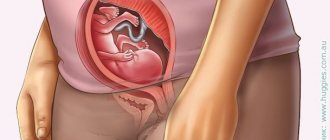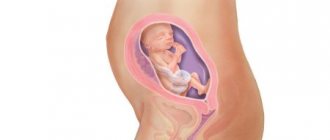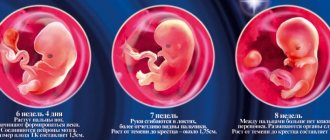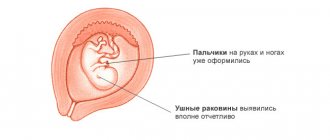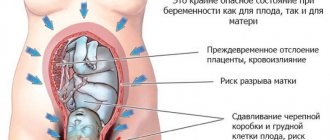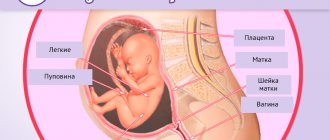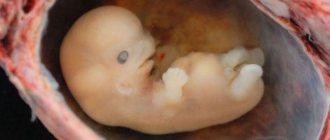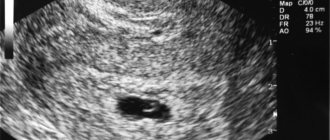Fetal development
Receiving all the necessary nutrients through the placenta, the baby gains weight every week. The skin smoothes out, becomes soft, and accumulates more and more pigment.
This is what your baby looks like at 28 weeks
Eyelashes lengthen and become fluffier. The hair on the head becomes longer and thicker, in addition, a pigment begins to be synthesized that colors it. The baby loses its transparency and colorlessness. Toenails and fingernails approach the edge of the fingers.
The formation of muscles is completed, muscle strength increases, which the mother cannot help but notice from the intense movements of the child. The formation of the skeletal system also ends. Next, the bones will accumulate calcium and harden.
Maturation processes in the lungs continue.
The structures of the central nervous system mature - there are more cells in the cerebral cortex, convolutions and grooves are formed. The centers responsible for taste and sound perception are activated. The formation of sucking and grasping reflexes occurs (the baby is already sucking his thumb and tugging at the umbilical cord with his hands). Already this week, the fetus becomes aware of its native language.
Baby moving
Third trimester, 28 weeks pregnant - how many months are left before giving birth? If the baby is not requested ahead of time, then the expectant mother has another 3 obstetric months left. This is an opportunity to set yourself up for a positive outcome, pack your bag for the maternity hospital, and prepare the necessary documents. If suddenly there is a need to suddenly leave for the maternity ward, all things will already be collected.
At the 7th month of pregnancy, fetal movements are most active. They must occur at least 10 times in one hour. Here you should be careful when counting. Because the baby can sleep during the day. And at night, when you wake up, begin your physical activity and movements.
We should not forget that the belly at 28 weeks of pregnancy is quite large. Sometimes it turns to stone - this means that the uterus is in good shape and is preparing for future contractions. The baby is also growing and there is not enough room for him in his mother’s tummy. Therefore, movements may not be as frequent.
During daytime or nighttime rest, the uterus relaxes, and the baby's activity increases. Therefore, when counting, you can detect at least 4 movements per 1 hour of mother’s rest.
Pay attention to fetal movements. If there is less movement than expected, you should tell your doctor about it.
Ultrasound at 28 weeks of pregnancy
A woman is sent for an ultrasound examination at the 28th week only if indicated, or if for some reason she did not have time to do it earlier. In this case, all measurements included in the research protocol are performed.
If the screening took place earlier, then at this time the main dimensions of the fetus are determined, indicating whether its development corresponds to the gestational age, its position in the uterus, the amount and condition of amniotic fluid, the size and degree of maturity of the placenta are assessed.
As a rule, by the 28th week the fetus is located in the uterus as it plans to be born. Most often, head down. If a transverse, oblique or breech presentation is detected, the woman may be prescribed exercises to help the baby roll over. If it is not possible to “convince” him, the woman will most likely have to give birth by caesarean section.
Late toxicosis during pregnancy
Late toxicosis during pregnancy appears at 28-29 weeks and is a serious reason to seek medical help. If your arms and legs swell, nausea persists, and headaches plague you, you should immediately report your symptoms to your doctor. The phenomenon of toxicosis is often underestimated, citing the adaptation of one's own body to the emergence of new life. Perhaps unpleasant symptoms do not portend anything bad, but only in the early stages of pregnancy. Late toxicosis in pregnant women, if not treated in a timely manner, can lead to irreversible, sad consequences.
Symptoms of late toxicosis during pregnancy
Late-term toxicosis or, as it is also called, gestosis occurs in the third trimester of pregnancy and can progress until childbirth. As a rule, this phenomenon is observed in 10-20% of pregnant women. To avoid being included in this number, you should be attentive to all the changes that occur in your body.
The causes of late toxicosis have not been fully established. But the factors that provoke the development of gestosis include stress, a sedentary lifestyle, hereditary predisposition, thyroid diseases, chronic diseases, age factor and nervous disorders.
The first symptoms of late toxicosis during pregnancy are swelling of the limbs and face. At the same time, you feel constant thirst, and the amount of urine produced decreases significantly. Edema is called a mild form of gestosis, which can be treated with lifestyle adjustments and a special diet.
A sign of late toxicosis is also high blood pressure. Therefore, you should especially carefully monitor your blood pressure, measuring it not only during a visit to your doctor, but also yourself - at home.
Development of late toxicosis
The next stage of gestosis, which occurs after swelling, may be the development of nephropathy, which is accompanied not only by severe edema, hypertension, but also by an increased protein content in the urine. It's worth noting that you may not experience all the symptoms at once, and the swelling may be subtle. The most accurate sign of nephropathy is hypertension. Doctors say that an increase in blood pressure above 135/85, as a rule, indicates developing toxicosis.
The appearance of preeclampsia and eclampsia at the last stage of gestosis is what late toxicosis is really dangerous for. Preeclampsia is accompanied by increased blood pressure, water-salt imbalance, disturbances in the functioning of the cardiac system, liver function, headaches and blurred vision. In this case, urgent hospitalization is recommended, since preeclampsia can progress to a more serious stage - eclampsia. At this stage, convulsions lasting up to two minutes, as well as loss of consciousness, appear. It is worth noting that eclampsia can be fatal not only for the fetus, but also for the mother.
Prevention of late toxicosis
The first thing to do when late toxicosis begins is to seek qualified medical help. Even in the early stages of gestosis, constant monitoring by the attending physician is indicated, who could monitor the appearance of symptoms and possible complications.
Do you always follow doctors' orders?
Yes, they know us better.
54.64%
Not always, because more information can be obtained from other women in labor.
17.53%
I comply, but I check reviews and advice from various mothers.
27.84%
Votes: 97
In addition, you can get advice on how to avoid late toxicosis from a specialist who is monitoring the course of your pregnancy. Special gymnastics, a healthy lifestyle, proper nutrition, walks in the fresh air, good sleep and, of course, a good mood for the entire period of pregnancy bring good results.
What happens in your body at 28 weeks?
All changes are expected - you continue to gain weight.
The child is growing and the uterus is increasing in size; now it is located at a distance of 28 cm from the symphysis pubis. This arrangement greatly complicates the process of breathing and digestion. To inhale, a woman needs to make more and more effort. Eating even a small amount of food causes a feeling of fullness in the stomach, heartburn is difficult to correct, and constipation has become almost the norm.
The breasts continue to fill, the amount of colostrum increases.
Hormones do not always have a positive effect on the skin; it becomes dry, which further contributes to the appearance of stretch marks on the hips, chest and abdomen. In addition to being an aesthetic problem, stretch marks also cause a feeling of constant itching. Scratching and infection should be avoided.
The double load on the kidneys leads to disruption of their function and the appearance of edema.
A large uterus disrupts the venous outflow in the pelvic area, which leads to varicose veins in the genital area. And constipation contributes to the appearance of cracks in the anal area.
Nutrition
It is better to distribute meals 5-6 times during the day. Preference should be given to small portions. Changes in taste and the appearance of unpleasant sensations often accompany pregnancy. 28 weeks - what happens in the last trimester?
The appearance of heartburn is due to the fact that as the uterus enlarges, the diaphragm also rises. It puts pressure on my stomach. Therefore, heartburn and nausea are quite acceptable.
A pregnant woman simply needs to take foods containing calcium: cheese, cottage cheese, milk. The child’s inert system continues to form, and calcium is needed by both mother and baby. But it is better to limit the intake of potatoes, flour products, and white rice - these products will contribute to fat accumulation in a woman’s body. It is better to prefer cereals and brown rice. For baking, use coarse flour.
How you feel at 28 weeks
The woman's condition can be assessed as rather satisfactory. During a normal pregnancy, unpleasant sensations such as heartburn, constipation, back pain, and heaviness in the legs are of little concern to the expectant mother. Most likely, you have already become accustomed to them and have come to terms with them.
Now all attention is paid to the child - if everything is fine with him, the expectant mother is ready to endure a lot. You should note any changes in the baby's behavior (decrease or increase in activity), monitor discharge, and the tone of the uterus.
Sometimes training contractions appear - the tone of the uterus increases, it becomes hard, then relaxes. The condition should not be repeated more than 10 times a day, and its duration should not exceed 2 minutes.
Changes in the body
Due to the size of the abdomen, it is highly recommended to purchase a support bandage that will help relieve stress on the spine.
The woman continues to suffer from problems with the gastrointestinal tract, but they can be eliminated by changing her diet and eating vitamin-rich foods.
The expectant mother may experience not only lower back pain, but also discomfort in the pubic joint. This is an indication that under the pressure of the uterus the muscles begin to stretch.
It will not be possible to completely remove the pain, but it will be possible to alleviate its manifestations. To do this, you need to carefully monitor your diet and daily schedule, practice yoga and swimming. In the third trimester, it is important to relieve stress on your knees and ankles.
There is also a pulling sensation in the lower abdomen, this is a symptom of Braxton-Hicks training contractions.
Difficulty breathing due to the already mentioned rise of the diaphragm cannot be avoided. After childbirth, this and many other unpleasant symptoms will disappear without a trace.
A woman may experience swelling in her arms and legs. You can get rid of it by eliminating salt from the diet and adding various fruit drinks. They will help remove excess fluid from the body.
Additionally, one can note not only an increase in the abdomen, but also in the hips and buttocks.
Colostrum begins to be released from the nipples, and the breasts should be washed with water at room temperature. You can use baby soap. Use a hard towel for drying.
You need to check your weight at the end of each week. If your weight does not increase or even decreases, this is a negative sign and you should consult a specialist.
The discharge does not change its color, quantity or smell. If any atypical discharge is detected, you should also contact a specialist.
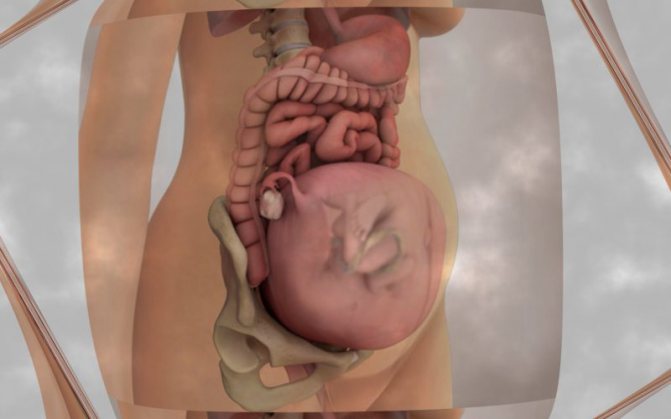
Discharge from the genital tract
The norm for discharge at this stage of pregnancy is light, moderate, liquid discharge with a subtle sour odor.
Any change in the color, smell or consistency of the discharge may indicate the development of pathology. Green and yellow with an unpleasant odor indicate the development of an infection. Bright red or brown appear when there is a threat of premature birth or placental abruption.
Deviation in any direction should be a reason to seek medical help
Discharge
Light, milky shades of discharge are considered normal. They should be homogeneous and have a slightly sour smell. If the discharge changes sharply, becomes yellow, gray, with clots of pus or mucus, you should immediately consult a doctor. If itching and a strong odor appear, a series of tests must be performed to identify the infection.
Watery discharge means leakage of amniotic fluid. They can be minor or abundant. In any case, watery discharge indicates a violation of the integrity of the fetal bladder. It is necessary to urgently consult a doctor.
If you are 28 weeks pregnant, what happens when you have bleeding? This means previa, placental abruption. You should definitely call an ambulance in this case. Bloody discharge may be slight and spotting. Or profuse, with sharp pain. In any case, they disrupt the normal course of pregnancy and can lead to premature contractions and childbirth.
Photos of bellies at 28 weeks
Examinations at 28 weeks
If you are scheduled to appear at the antenatal clinic at this time, then, most likely, the doctor will recommend such control tests as a general urine test, a general blood test, and an antibody titer with a negative Rh factor. In addition, according to indications, smears will be taken for flora and culture will be performed.
It is mandatory to measure the abdominal circumference and the height of the uterine fundus, blood pressure in both arms and the weight of the pregnant woman with an assessment of the increase throughout the pregnancy and since the last weighing.
Feelings and well-being of the expectant mother
- At this stage of pregnancy, the expectant mother will have to undergo a number of mandatory examinations and be prepared for frequent meetings with her gynecologist.
- Another check of hemoglobin and glucose levels in the blood is carried out.
- If a woman has a negative Rh factor, she must be periodically tested for antibodies.
- Consult your gynecologist whether sex is allowed for you at 28 weeks of pregnancy, and if there are no contraindications, you can not deny yourself pleasure.
- For the normal course of your pregnancy, a balanced and proper diet, daily walks in the fresh air, absence of stressful situations, and proper rest are also important.
We invite you to take a photo of your own belly as a souvenir during this time. Such pictures bring mothers extremely positive emotions. And your photo of the belly, along with a photo of the baby taken at 28 weeks of pregnancy, can be placed in a separate album, the pictures of which will become the beginning of the story of your child’s life.
Now you are in the twenty-eighth week of pregnancy, the uterus is growing more and more, and for this reason a woman may more often experience various uncomfortable sensations.

Pain in the spine and lower back, characteristic of expectant mothers in the second trimester of pregnancy, appears due to a shift in the center of gravity, stretching of ligaments and softening of joints. Spontaneous aching lumbar pain, radiating to the hip, knee and ankle, is a consequence of compression of the sciatic nerve by the enlarged uterus.
Sharp and severe spasmodic lumbar pain requires immediate calling an ambulance.
Such sensations indicate that you may be going into premature labor at 28 weeks of pregnancy.
Do not worry if minor swelling of the legs, arms, or face appears. You just need to review your diet, reduce your salt intake, and control your fluid intake. But sometimes swelling can be a symptom of gestosis, a serious complication of pregnancy.
Risks at 28 weeks
There is also a risk of premature birth this week - the rapidly growing baby puts pressure on the cervix and can contribute to its early dilatation. When lifting heavy objects, sudden movements, or for no apparent reason, rupture of the membranes may occur with the release of amniotic fluid and the onset of labor.
The same reasons can cause premature placental abruption - this is the most dangerous condition - the supply of oxygen to the baby is disrupted and he may die.
There is also a significant risk of infection of the fetus, which is associated with decreased immunity during pregnancy, and constantly recurring colpitis against this background.
Important at 28 weeks
Don't forget to wear a bandage - it will help avoid pressure from the baby's head on the neck and prevent it from opening early. The bandage will also relieve your back and reduce discomfort. It is not recommended to wear a bandage only for women whose baby is not in the correct (head) presentation.
Avoid sudden movements, heavy lifting and intense physical activity.
Choose loose-fitting clothes made from natural fabrics. Shoes have small wide heels. If you are prone to varicose veins, ask your doctor to help you choose compression garments that you will need to take with you to the maternity hospital.
Fetal location
The baby already knows how to hear, he begins to distinguish the voices of his parents. He opens his eyes and reacts emotionally to what he likes or doesn’t like. If pregnancy is 28 weeks - what happens to the fetus? When will it roll over into the correct position?
There are only 3 types of fetal presentation:
- The main thing. The baby is head down, adjacent to the cervix.
- Transverse. The fetus is located across the mother's abdomen.
- Pelvic. The baby is head up, the fetal legs and buttocks are adjacent to the cervix.
Until the 3rd trimester this is not a big deal. The baby's activity increases, he moves regularly and can be in any of the three presentations. If the pregnancy has reached 28–29 weeks, the fetus is in the most convenient position for childbirth. Most often it is a cephalic presentation. It is optimal for childbirth.

With a breech presentation during childbirth, the baby’s buttocks and legs appear first. It may be difficult to remove the head, since it is the largest part of the body. Therefore, the prospect of a caesarean section is possible.
With a transverse presentation, the baby will not be able to be born on its own, without medical assistance. It is during this period, when the pregnancy is 28–29 weeks old, that the official diagnosis of fetal presentation is made. However, there is no need to worry ahead of time. It also happens that just before birth the baby finds himself in a cephalic presentation.
Nutrition at 28 weeks
Eat not for two, but for two. The contents of your plates should be healthy and balanced. Be sure to include fresh and thermally processed vegetables and fruits in your diet - they will help normalize intestinal function. It is best to drink clean, non-carbonated water, compotes, fruit drinks, and green tea. Save coffee and carbonated drinks until you stop breastfeeding.
Forget about fast food, alcoholic drinks and store-bought canned goods - they can cause irreparable harm to your child.
